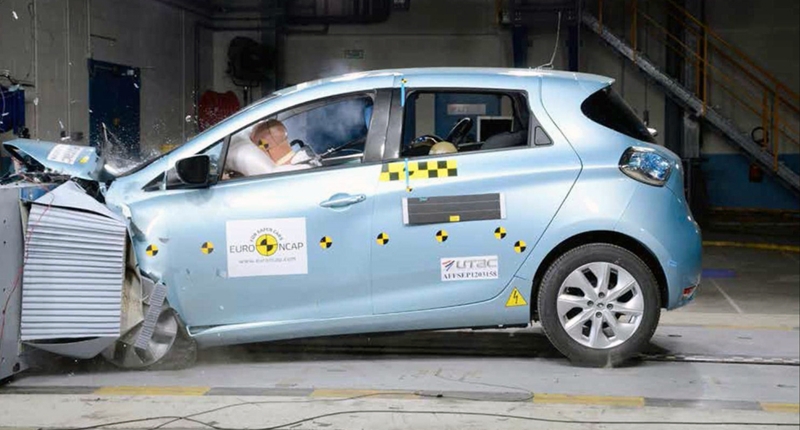The safety technology in your car is rather like that long-forgotten first aid kit tucked away at the bottom of a musty drawer – about as useful as a wooden frying pan until the unthinkable happens. Until it all goes wrong. Until you crash.
No, weâ€
No ad to show here.
This makes sense, since very few people shell out for a new set of wheels with the express intention of crashing. “Just popping out for a quick head-on collision, dear… want anything?†said Nobody. Ever.
Of course, these days safety tech includes more than just passive systems such as padded dashboards, seatbelts and airbags. Yes, the safest of modern cars also employ all manner of active systems capable of preventing collisions from happening in the first place. Basically, cars use these safety setups to bring you back from the brink – which is sort of like having a defibrillator in that home medical kit.
So, what if you based your next car purchase solely on safety factors? What if you blew things with Sally (it was never going to last, anyway) and all you cared about was getting home to your thirteen cats in one piece? Youâ€
Bear in mind that Euro NCAP does not test every variant of every new car to hit the global market – its selection is based on providing the broadest range of information to consumers, with an emphasis on the most popular and (what it deems) the most interesting models. So while this list doesnâ€
Each vehicleâ€
So, here are 2013â€
Supermini Class: Renault ZOE
Adult Occupant: 89%
Child Occupant: 80%
Pedestrian: 66%
Safety Assist: 85%
Renaultâ€
The ZOEâ€
Small Family Class: Qoros 3 Sedan
Adult Occupant: 95%
Child Occupant: 87%
Pedestrian: 77%
Safety Assist: 81%
The what, you ask? Qoros is a joint venture between Chinese automaker Chery and the Israel Corporation, founded as long ago as 2007. And now the Shanghai-based enterprise has finally unleashed its first production vehicle, dubbed the Qoros 3. And what a well put-together small family sedan it appears to be. In fact, overall it was the safest car tested in 2013.
Euro NCAP boffins report that the Qoros 3 excels in driver and passenger tests, with all regions of an individualâ€
Large Family Class: Lexus IS 300h
Adult Occupant: 91%
Child Occupant: 85%
Pedestrian: 80%
Safety Assist: 66%
The hybrid model in the stunning Lexus IS range is predictably strong in the adult and child occupant protection stakes, performing remarkably well in even the hardcore side-pole and rear-end collision tests. But itâ€
The front bumper houses sensors that detect when a pesky pedestrian has been struck, instructing actuators to raise the impact-absorbing bonnet, providing more space between it and the skull-splittingly hard engine components underneath. The result? A vastly reduced risk of serious head injury — regardless of whether the pedestrian is short or tall. However, the IS 300h doesnâ€
Small MPV Class (shared): Kia Carens
Adult Occupant: 94%
Child Occupant: 76%
Pedestrian: 64%
Safety Assist: 81%
The fourth generation of Kiaâ€
But the Korean car-maker goes a long way to redeeming itself in the safety assist department, thanks to a seatbelt reminder system that includes even the third row in seven-seater models.
Small MPV Class (shared): Ford Tourneo Connect
Adult Occupant: 94%
Child Occupant: 85%
Pedestrian: 62%
Safety Assist: 70%
The van-based Tourneo Connect shares the Small MPV award with the Kia Carens, but delivers better protection to child-shaped cargo. Adult protection is also commendably high, with not much compromise across occupants of different sizes or sat in different positions.
But if you see an example of Fordâ€
Off-Road Class: Jeep Cherokee
Adult Occupant: 92%
Child Occupant: 79%
Pedestrian: 67%
Safety Assist: 74%
The new Cherokeeâ€
The front bumper achieves decent marks in the pedestrian tests, but the leading edge of the bonnet shows “poor levels of protection to the pelvis regionâ€. The bonnet surface itself returns mixed results. The Cherokee scores points for the standard fitment of electronic stability control and a seatbelt reminder system, but loses out on better overall marks since its speed assistance system is warning-based only.
Executive Class: Maserati Ghibli
Adult Occupant: 95%
Child Occupant: 79%
Pedestrian: 74%
Safety Assist: 81%
As illustrated by its 95% rating for adult protection, the Ghibliâ€
Children are also theoretically well protected, although Euro NCAP says that Maserati drops the ball when it comes to clearly indicating the status of the front passenger airbag (which can be disabled for child-seat use). Also, the risks of using a rear-facing child seat up front without first disabling the airbag are not permanently indicated in the vehicle. Pedestrians, meanwhile, are well covered in all areas except the base of the windscreen, while electronic stability control, seatbelt reminders and a driver-set speed limiter see the Ghibli score well in the safety assist section.
